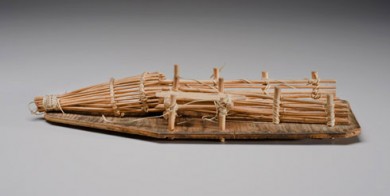Gwich'in Name
-
Teetł’it Gwich’in Name:
K’oo Play Audio -
Gwichya Gwich’in Name:
K’adh Play Audio -
Vuntut Gwitchin Name:
K’oo Play Audio
 “The fish trap was something else our ancestors used a great deal, and perhaps it was the best and easiest method used in catching fish. The following is needed in order to build a fish trap: eddy, long wooden poles with bark left on, long wooden poles with bark cleaned off. The first thing to do was choose a good eddy. Directly downstream from this eddy is where the trap was built. The poles with bark are driven into the bottom with an opening in between. Poles were then put horizontally, like a fence. The next thing to do was to build a long basket. This was made from the clean wooden poles, and it was set in the opening, and the small end was closed. Then you waited. The fish would come along and swim straight into the trap in great numbers. The fish were then scooped into the canoe with a large willow dipper with a long handle. A lot of fish were caught this way.”
— Elijah Andrew, Teetl’it Gwich’in Elder, 1970s
“The fish trap was something else our ancestors used a great deal, and perhaps it was the best and easiest method used in catching fish. The following is needed in order to build a fish trap: eddy, long wooden poles with bark left on, long wooden poles with bark cleaned off. The first thing to do was choose a good eddy. Directly downstream from this eddy is where the trap was built. The poles with bark are driven into the bottom with an opening in between. Poles were then put horizontally, like a fence. The next thing to do was to build a long basket. This was made from the clean wooden poles, and it was set in the opening, and the small end was closed. Then you waited. The fish would come along and swim straight into the trap in great numbers. The fish were then scooped into the canoe with a large willow dipper with a long handle. A lot of fish were caught this way.”
— Elijah Andrew, Teetl’it Gwich’in Elder, 1970s
Catalogue Data
| Materials: | wood, caribou thong |
| Dimensions: | L. 38 cm; W. (wide end) 11 cm |
| Date: | 1963–1964 |
| Made by: | Brian Francis, Fort McPherson, Northwest Territories |
| Collected by: | Richard Slobodin, Fort McPherson, Northwest Territories, 1963–1964 |
| Catalogue number: | CMCC VI-I-51 |
Manufacture and Use
-
About the Artifact
“A side-stream trap, used mainly on small tributaries of the main river — the Peel in this case — but...
Read more -
About the Collector
Richard Slobodin (1915–2005) first visited the Gwich’in community of Fort McPherson in the winter of...
Read more -
About the Maker
“The model moose-skin boat, fish trap (basket) and snowshoes were made by Brian Francis of Ft. McPherson,...
Read more













